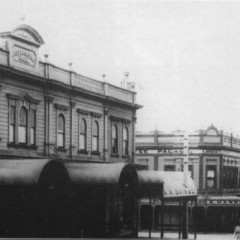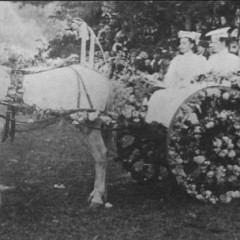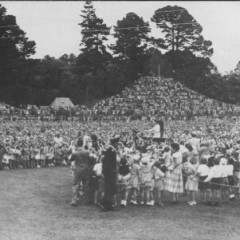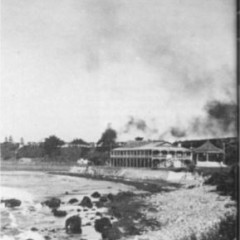10:3
On May 9, 1867, Woon sold his newspaper to his father-in-law, William George, a former publican, and later that year the Taranaki Herald became the property of "Henry Weston, gentleman'. Thus began a family association with the newspaper which lasted for 111 years. Henry Weston was sole proprietor from 1867 until 1920, when his nephew, Walter C. Weston, assumed his role until 1930. In that year the business was registered as a private company, with Walter Weston as chairman and managing director. Lillian Weston, his wife, was a director until her death in 1978. In 1962 the Taranaki Herald and the Taranaki Daily News, both of which were having problems coping with increasing costs and the need for up-to-date equipment, were amalgamated as Taranaki Newspapers Ltd, a subsidiary of NZ News Ltd, Auckland, which owned several other publications, including the Auckland Star and Christchurch Star. Henry Weston changed the Herald's format slightly in 1867 when the paper appeared twice weekly, and in 1877 it began appearing daily. From hand-set type to linotypes and, in 1975, to computerised setting and photographic 'type'; from the primitive hand-operated Albion Press to a four-decker Foster rotary machine, the Herald grew from a four-page weekly to an eight-page daily by the turn of the century and in the past 80 years it has increased its coverage, circulation and size and has featured many special supplements, some as large as 100 pages. The paper has occupied several premises since its birth in the little shed behind the present Whites building. In 1859 it moved to new premises in Devon Street where it was produced until fire destroyed much of the building and materials in 1900, when it moved to its present site. There had been minor fires before, but none as serious as this one, in which incendiarism was suspected and a man arrested, but two Supreme Court juries did not find the charges justified. Putting aside the spirit of rivalry the Taranaki Daily News assisted in production of the Herald. Nine years later another fire gutted part of the Currie Street building and destroyed the press, and, again the News came to its rival's assistance. Ironically, neither fire nor flood (on one occasion a monsoon-type downpour inundated the pressroom) prevented publication; it was a strike in 1978 by journalists, who had established a union 20 years previously, which resulted in the cessation of the paper for several days. Editors since the Weston family acquired the Herald have included William Seffern (1868-1895), a prolific writer who acquired a reputation as an historian, publishing five books which are now collectors' pieces; Walter J. Penn 1895-1932; G. H. Dolby 1932-1937; A. B. Scanlan from 1937 to 1941 when he became managing editor until the amalgamation when his title reverted to editor (he resigned in 1965); and R. J. Avery 1965 to 1973 when he was appointed editor of the Daily News. Present Herald editor is G. K. Koea. Other newspapers to be published by the Herald have included the Budget and the Taranaki Weekly Herald, from May 14, 1877, to December 31,1932; the Sports Herald, 1926-1930 and 1946-1972; and during World War Two a special Overseas News Sheet launched weekly for servicemen. In common with most other newspapers, the Herald-and, since the amalgamation, Taranaki Newspapers Ltd-has conducted a jobbing department for more than 100 years. A wide range of material, from full-length books to invitation cards, has been produced, and its equipment has kept pace with increasing sophisticated trends in printing. The Taranaki Daily News was born on May 14, 1857, 'to prevent a monopoly in the presentation of news and views'." The two men behind its establishment were Charles Brown and Richard Pheney. When the Herald decided to support George Cutfield instead of Brown as superintendent of the province, Pheney, editor of the Herald, resigned. Following Brown's defeat a meeting of' interested parties' was called to a large room in the Masonic Hotel (now the site of the Bank of New Zealand). It was attended by a few friends of Brown and a smaller number of those who, as in any community, were willing to have a go at any new proposal. Brown, 'a pushful energetic trader smarting under political defeat, and Pheney, an ex-Cockney trader who preferred the pen to the bill-hook, smarting under the loss of the editorship he felt he should have retained only by the sacrifice of principle' ,both addressed the meeting with the result that the News was established with Brown as 'conductor', Pheney as editor and W. Collins as printer. It was housed in a small wooden building on the east side of Brougham Street, opposite the present library, and like its rival, the Herald, it has occupied several other premises-in Devon Street opposite the Opera House, the' Iron Store' on the corner of Currie and Devon Streets, and in the Roebuck building on the corner of Currie and Powderham Streets until the amalgamation of the two papers. It had, if that were possible, more problems to contend with than had the Herald: there was a chronic shortage of everything, including money, and the threat of trouble with the Maoris was increasingly growing more real. As expected, its first issues were widely critical of the Herald and of the Provincial Government. But it also found space to refer to 'the issues of the day', to cricket matches, and to make known its policy of supporting any firm stand concerning' Maori rebels against the authority of the Crown', an attitude which was maintained throughout the years of fighting.
In 1860 Brown was given a military commission and Pheney became sole proprietor of the weekly, which was published on Saturdays (later on Mondays). Paper shortages plagued its production; its size (and its price) was reduced by half, on two occasions it had to print on dark blue packing paper, and in 1867, when things looked a little brighter, it promised its readers 'an entirely new start'. But it was forced to admit that, because of 'shipping contingencies', subscribers would have to await 'the return of the Airedale (when) we shall publish the other half of our present issue'. Four years after the fighting ended Brown (now Major Brown) resumed proprietorship, and his forceful personality soon became apparent. His old feud with the Herald was revived; he attacked its accuracy and good faith, which obviously gave much enjoyment to readers and no doubt boosted circulation a little. The tide was turning for the province and the News became tri-weekly. In 1874 it announced it would publish three issues for town readers and one for its country subscribers. The town issues would be known as The Taranaki Advertiser, the fourth retaining the title Taranaki News. Because the new titles had not been registered with the Post Office, it was found necessary to revert to the old Taranaki News title. Brown decided early in 1875 to issue a new evening penny paper which would be known as the Budget, but his plans were countered by James Kenworthy who, using the Herald's press and other good offices, brought out his own Budget. Brown retaliated by making the News a morning daily from January 21, 1875, and in June of that year it became a daily evening. It was a losing battle, however, and in August Brown sold out to Thomas Avery and W. Edmondson, who decided to begin again as a weekly. To establish that a new era had begun the first issue was numbered Volume One, Number One. 'The good ship News', said the editorial, 'stormbound and worn, has been into dock for renovation and today it comes forth gaily with a new captain and crew.' This was not strictly correct. The 'crew' had sailed with the ailing News under the editorship of Benjamin Wells for several months, and although the first leading article expressed the hope that cordial relations would exist with the Herald and its weekly Budget, Wells himself apparently did little to bring this about. In a subsequent issue he wrote: 'A dung cart happening to break down in front of the Budget office on Saturday last furnished the editor of that journal with ready materials for a paragraph. Possibly this may account for the stercoraceous character of the materials pitchforked together in the Budget that day. Similis simili gaudet.' Gradually the chaotic conditions improved under A very and Edmondson's influence. A very was a first-class printer and Edmondson a shrewd businessman with considerable literary ability (he assumed editorship when Wells died in 1881). Circulation improved and new machinery was installed. In April, 1881, the paper stated it was printed by machinery driven by a gas engine-'The first time gas has been used a a motive power in Taranaki.' A very pulled out of the partnership in 1883 to begin ajob-printing and stationery business which has flourished in the town for almost a century. J. W. King became Edmondson's partner and another decline began. On August 9, 1884, the News imprint revealed that it was' printed and published for Charles Brown, proprietor, by Wm Edmondson of New Plymouth. C. Brown editor.' A fortnight later it was announced that the paper would in future be conducted by a new proprietary comprising John McKenzie, William Adam King and Ludovic Lafage Norris as editor. In Novemberthe incorporation of the Waitara Press was notified and a general increase in country news promised. By June of 1885 the News appeared as a daily paper with the Weekly News as its Saturday edition. For a while the paper was called The Taranaki News and the Waitara Press. Later the title Taranaki Daily News was adopted, and the weekly edition was continued. In the next 20 years more changes occured. Control was variously in the hands of William Edward Simpson; John McKenzie and J. Guerin until a local company, the Taranaki Daily News Co. Ltd, was floated with J. B. Connett as chairman and Guerin as editor. Guerin was replaced by Arthur (later the Rev.) Hopper, and later by Edwin Allsworth as managing-editor. Such frequent changes of ownership and 'conductorship' did little, in spite of Connett's considerable financial backing, to help the paper's prosperity, and in 1903 the Taranaki Daily News Co. Ltd was able to sell the paper to James Henry Clayton in terms which would return investors in the company 20 shillings in the pound, as grateful shareholders acknowledged at a meeting held to thank Mr Connett for his efforts on behalf of the company. On December 2, 1905, Clayton announced the sale of the company to Thomas Currie List, claiming that he had 'placed the paper on the high road to prosperity'. It did not take long for the new owner to discover that in spite of Clayton's observations, the paper was practically moribund, and for a year it was doubtful if recovery was possible. List discovered one of the reasons for lack of profitability within a fortnight of his taking over. The News was regularly printing 500 copies a day, but there were fewer than 200 regular subscribers, so that about 300 copies were being distributed free to anyone who wanted them. The paper at this time needed goodwill and advertising, so List cut out only some of the free papers in an attempt to make the best of both worlds.




